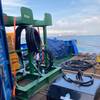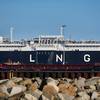TT Club Addresses Crane Safety in Windy Conditions
Analysis of the TT Club’s claims over a number of years has highlighted that wind damage to quayside cranes is the biggest weather related cost to terminals. Due to their size, profile and location on the quayside, these cranes are particularly susceptible to wind, and care must be taken in the design and operating procedures to protect against the crane being blown over or along the rails.
Such incidents can be prevented, or at least the collateral damage caused can be restricted, by having appropriate procedures and ensuring that they are followed. Essential elements include: having effective national and local weather forecasting systems and ensuring that operational procedures respond appropriately when sufficient warning is forthcoming. In addition, good practice would dictate that storm pin or tie-down facilities and procedures are invoked.
Furthermore, appropriately designed braking systems, which are properly maintained, can significantly help in conditions of sudden wind bursts. There are two major windstorm issues to be considered: protection against forecast strong winds, and protection against sudden local winds called micro-bursts.
In the case of forecast strong winds, storm pins and tie-downs of sufficient number and size to hold a crane structure stationary (and procedures to implement these) are required to protect quayside cranes. Storm pins are vertical sliding pins mounted at suitable positions under each leg of the crane. These pins are dropped into sockets set into the surface of the berth. The pins must be interlocked with the travel motion so that the crane can only be moved when the pins are disengaged.
Storm tie-downs are connections on the crane, normally at the four corners, where suitable slings, chains or bars of appropriate size and number are fitted to connect to anchor points in the terminal pavement. These anchors must be able to hold the loadings of the crane under potential wind conditions.
The other situation of primary danger is the occurrence of microbursts. In the worst circumstances, unknown to the driver, a strong wind arises blowing in the same direction in which the crane is travelling and the driver is unable to stop the motion of the crane. To deal with these situations, suitable storm brakes and service brakes are necessary and should be fitted to the crane. These are not however, an acceptable alternative to pins or tie-downs for forecast weather conditions.
There are a number of different systems used for storm brakes or, as they are sometimes called, parking brakes. These include rail clamps and railhead brakes. However, these are static brakes. They are only applied when the crane has stopped moving. They normally operate if the emergency stop is activated and unless severely damaged will help prevent a stationary crane from being pushed along by the wind. Their main purpose and benefit is to park and anchor the crane between normal operations without the need to apply the storm pins or tie-downs.
If rail clamp and railhead brakes are applied when the crane is moving, both the brakes themselves and the crane rail can be damaged. For this reason, wheel brakes should also be installed. These are normally disc brakes mounted on the crane wheels. Finally, the service braking system forms the normal operating brake. This is part of the motor and gearbox of the crane, which slows and ultimately stops the crane during daily working.
Apart from accurate weather forecasting and adequate technical measures, both maintenance and training are crucial to safer procedures.
The TT Club urges terminal managers concerned with quayside cranes and bulk loaders/unloaders to review their emergency plans in respect of high wind situations and ensure that all necessary measures have been taken to prevent injury, damage and downtime arising from this cause.










